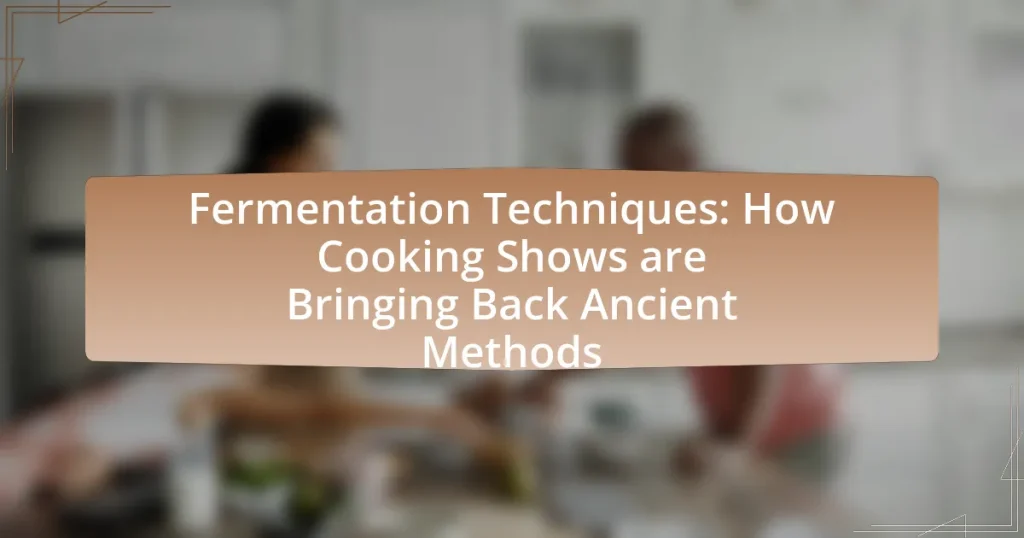Fermentation techniques are methods that convert sugars into acids, gases, or alcohol through microorganisms, playing a crucial role in food preservation and enhancing flavors. Historically significant for over 7,000 years, these techniques have influenced modern cooking by introducing diverse flavors and promoting health benefits through probiotic-rich foods. The article explores the revival of ancient fermentation methods, such as kimchi-making and sourdough baking, and highlights the impact of cooking shows and celebrity chefs in popularizing these practices. It also discusses various fermentation types, common mistakes to avoid, and future trends in fermentation techniques within culinary contexts.

What are Fermentation Techniques and Their Historical Significance?
Fermentation techniques are methods used to convert sugars into acids, gases, or alcohol through the action of microorganisms, primarily yeast and bacteria. Historically, these techniques have been significant for food preservation, enhancing flavors, and improving nutritional value. Evidence shows that fermentation dates back over 7,000 years, with ancient civilizations such as the Mesopotamians and Egyptians utilizing it for bread and beer production. The process not only allowed for the storage of food but also contributed to the development of various cultural cuisines, as seen in fermented products like kimchi in Korea and sauerkraut in Germany.
How have ancient fermentation methods influenced modern cooking?
Ancient fermentation methods have significantly influenced modern cooking by introducing diverse flavors, enhancing food preservation, and promoting health benefits. Techniques such as lacto-fermentation, used for centuries in cultures worldwide, have led to the popularity of foods like kimchi and sauerkraut, which are now staples in contemporary diets. These methods not only improve the taste and texture of food but also increase its nutritional value by introducing probiotics, which support gut health. Historical evidence shows that civilizations like the Mesopotamians and Egyptians utilized fermentation for food preservation, laying the groundwork for modern culinary practices that emphasize fermentation as a means to create complex flavors and improve food safety.
What specific ancient techniques are being revived today?
Specific ancient techniques being revived today include traditional fermentation methods such as kimchi-making, sourdough bread baking, and miso production. These techniques are gaining popularity due to their health benefits, including improved gut health and enhanced flavor profiles. For instance, the resurgence of sourdough bread can be traced back to its historical roots in ancient Egypt, where natural fermentation was utilized to leaven bread. Cooking shows and culinary influencers are increasingly showcasing these methods, emphasizing their cultural significance and nutritional advantages, thereby fostering a renewed interest in these time-honored practices.
Why were these techniques important in historical contexts?
Fermentation techniques were important in historical contexts because they played a crucial role in food preservation, nutritional enhancement, and cultural identity. Historically, societies relied on fermentation to extend the shelf life of perishable foods, as seen in ancient civilizations like Mesopotamia and Egypt, where fermented products such as bread and beer were staples. Additionally, fermentation improved the nutritional profile of foods by increasing bioavailability of nutrients, which was vital in times of food scarcity. Furthermore, these techniques fostered community and cultural practices, as seen in the diverse fermented foods across different cultures, such as kimchi in Korea and sauerkraut in Germany, reflecting local traditions and agricultural practices.
What role do cooking shows play in popularizing fermentation techniques?
Cooking shows play a significant role in popularizing fermentation techniques by showcasing these methods in an engaging and accessible format. They educate viewers about the health benefits and culinary versatility of fermented foods, such as kimchi, sauerkraut, and yogurt, often featuring expert chefs and home cooks who demonstrate the fermentation process step-by-step. This exposure not only demystifies fermentation but also encourages home experimentation, leading to a resurgence of interest in traditional food preservation methods. For instance, shows like “Chef’s Table” and “Salt, Fat, Acid, Heat” highlight the cultural significance and flavor profiles of fermented foods, contributing to a broader appreciation and adoption of these ancient techniques in modern cooking.
How do cooking shows educate viewers about fermentation?
Cooking shows educate viewers about fermentation by demonstrating the processes involved in fermenting various foods, such as vegetables, dairy, and grains. These shows often feature expert chefs or food scientists who explain the science behind fermentation, including the role of microorganisms like bacteria and yeast, and how they contribute to flavor development and preservation. For instance, programs may showcase the step-by-step preparation of fermented items like kimchi or yogurt, highlighting the importance of ingredients, timing, and environmental conditions. This practical approach not only provides viewers with recipes but also imparts knowledge about the health benefits of fermented foods, such as improved digestion and enhanced nutrient absorption, thereby fostering a deeper understanding of this ancient culinary technique.
What impact do celebrity chefs have on the revival of these methods?
Celebrity chefs significantly influence the revival of fermentation techniques by popularizing these ancient methods through their cooking shows and social media platforms. Their demonstrations and recipes showcase the benefits of fermentation, such as enhanced flavors and health advantages, which resonate with modern audiences seeking sustainable and artisanal food practices. For instance, shows featuring chefs like Sandor Katz, known for his expertise in fermentation, have led to increased public interest and participation in home fermentation projects, evidenced by a rise in sales of fermentation kits and related cookbooks. This trend highlights how celebrity chefs serve as key educators and advocates, effectively bridging the gap between traditional culinary practices and contemporary cooking culture.
What are the different types of fermentation techniques showcased in cooking shows?
Cooking shows often showcase various fermentation techniques, including lacto-fermentation, alcoholic fermentation, and acetic acid fermentation. Lacto-fermentation is commonly used for preserving vegetables, such as sauerkraut and kimchi, where lactic acid bacteria convert sugars into lactic acid, enhancing flavor and shelf life. Alcoholic fermentation is highlighted in the production of beverages like beer and wine, where yeast converts sugars into alcohol and carbon dioxide. Acetic acid fermentation is demonstrated in the making of vinegar, where acetic acid bacteria oxidize ethanol into acetic acid. These techniques not only preserve food but also enhance nutritional value and flavor, reflecting ancient methods that have been revived in modern culinary practices.
How does lactic acid fermentation differ from alcoholic fermentation?
Lactic acid fermentation differs from alcoholic fermentation primarily in the end products and the organisms involved. Lactic acid fermentation, performed by bacteria such as Lactobacillus, converts sugars into lactic acid, which is commonly found in yogurt and sauerkraut. In contrast, alcoholic fermentation, carried out by yeast like Saccharomyces cerevisiae, converts sugars into ethanol and carbon dioxide, which is essential in the production of beer and wine. This distinction highlights the different metabolic pathways and applications of each fermentation type in food production.
What are the benefits of using fermentation in food preparation?
Fermentation in food preparation offers several benefits, including enhanced flavor, improved nutritional value, and increased shelf life. The process of fermentation breaks down sugars and starches into acids, gases, or alcohol, which not only develops complex flavors but also makes nutrients more bioavailable. For instance, fermented foods like yogurt and sauerkraut contain probiotics that promote gut health and aid digestion. Additionally, fermentation can extend the shelf life of foods by creating an acidic environment that inhibits spoilage organisms, as seen in traditional methods of preserving vegetables and dairy. These benefits highlight the significance of fermentation in enhancing both the culinary experience and food preservation.
How can viewers implement fermentation techniques at home?
Viewers can implement fermentation techniques at home by following simple steps such as selecting appropriate ingredients, maintaining proper hygiene, and controlling environmental conditions. For example, to make fermented vegetables, one can use fresh produce, salt, and water, ensuring that all utensils are clean to prevent unwanted bacteria. The process typically involves submerging the vegetables in a saltwater brine, which creates an anaerobic environment conducive to the growth of beneficial bacteria like Lactobacillus. This method has historical roots, as fermentation has been used for thousands of years to preserve food and enhance flavors. Studies show that fermented foods can improve gut health and boost the immune system, making home fermentation not only a culinary practice but also a health-conscious choice.
What are some beginner-friendly fermentation recipes to try?
Beginner-friendly fermentation recipes include sauerkraut, kimchi, and yogurt. Sauerkraut involves shredding cabbage, mixing it with salt, and allowing it to ferment for several weeks, which promotes the growth of beneficial bacteria. Kimchi, a traditional Korean dish, is made by fermenting seasoned vegetables, typically napa cabbage and radishes, with spices and salt, resulting in a tangy flavor. Yogurt is created by adding specific bacterial cultures to milk and allowing it to ferment at a controlled temperature, transforming the milk into a creamy, probiotic-rich product. These recipes are accessible and provide a practical introduction to fermentation techniques.
What common mistakes should be avoided when fermenting at home?
Common mistakes to avoid when fermenting at home include neglecting proper sanitation, using the wrong temperature, and failing to monitor the fermentation process. Proper sanitation is crucial because harmful bacteria can contaminate the ferment, leading to spoilage or foodborne illness. Maintaining the correct temperature is essential, as most fermentation processes thrive between 60°F and 75°F; temperatures outside this range can inhibit fermentation or promote undesirable microbial growth. Additionally, not regularly checking the fermentation can result in over-fermentation or spoilage, as many ferments require specific timeframes to achieve optimal flavor and safety.
What future trends can we expect in fermentation techniques within cooking shows?
Future trends in fermentation techniques within cooking shows will likely include a greater emphasis on sustainability and local sourcing of ingredients. As audiences become more environmentally conscious, cooking shows are expected to showcase fermentation methods that utilize seasonal and locally available produce, thereby reducing carbon footprints. Additionally, there will be an increase in educational segments that explain the science behind fermentation, as viewers seek to understand the health benefits and culinary applications of fermented foods. This trend is supported by the rising popularity of gut health awareness, which has led to a surge in demand for probiotic-rich foods. Furthermore, innovative fermentation techniques, such as using alternative ingredients like plant-based proteins and non-traditional sugars, will be highlighted, reflecting the growing interest in vegan and health-oriented diets.
How might technology influence the practice of fermentation in cooking?
Technology significantly influences the practice of fermentation in cooking by providing precise control over environmental factors such as temperature, humidity, and pH levels. Advanced fermentation equipment, like temperature-controlled fermentation chambers and pH meters, allows chefs and home cooks to create optimal conditions for microbial activity, leading to consistent and predictable results. For instance, studies have shown that maintaining specific temperature ranges can enhance the flavor profiles and health benefits of fermented foods, such as yogurt and kimchi. Additionally, digital platforms and apps facilitate knowledge sharing and community engagement, enabling users to access fermentation recipes and techniques from around the world, thus revitalizing ancient methods through modern technology.
What emerging fermentation methods are gaining popularity?
Emerging fermentation methods gaining popularity include koji fermentation, which utilizes the mold Aspergillus oryzae to enhance flavors in various foods, and wild fermentation, which relies on naturally occurring microorganisms for unique taste profiles. Koji fermentation has been increasingly adopted in the production of products like miso and sake, reflecting a growing interest in umami flavors. Wild fermentation, often seen in artisanal bread-making and craft beverages, emphasizes the use of local microbes, promoting biodiversity and distinct regional characteristics. These methods are gaining traction due to their ability to create complex flavors and promote sustainable practices in food production.
What practical tips can enhance your fermentation experience?
To enhance your fermentation experience, maintain a clean environment and use high-quality ingredients. A sterile workspace prevents contamination, which is crucial for successful fermentation, as unwanted bacteria can spoil the process. Additionally, using fresh, organic ingredients ensures that the natural microbes needed for fermentation are present and active, leading to better flavor and texture in the final product. Research indicates that the quality of ingredients directly impacts the fermentation outcome, as noted in studies on microbial activity in food preservation.










